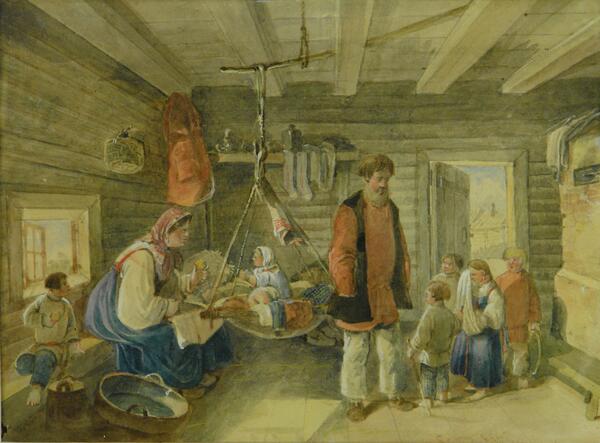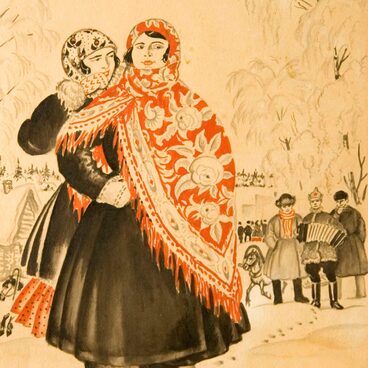Karl Kollman was a watercolor painter and lithographer from Augsburg. Having received an art education in Munich, at the age of 17 he moved to Russia. He gained fame among his contemporaries, creating watercolors on village life, street scenes from the life of Saint Petersburg, and types of common people.
During his lifetime, his works became the object of collecting by graphics lovers.
The peasant theme in world art became widespread in the 19th century, in the era of social revolutions and urbanization. The image of a villager and a farmer in Europe turned out to be synonymous with the true embodiment of a people close to the earth. At the same time, in Russia the peasantry began to personify the ‘spirit of the nation’, the bearer of moral and cultural values. The first artistic attempts to reflect the collective image of a peasant arose after the Patriotic War of 1812. Peasants became full-fledged heroes of the compositions in the painting of Alexey Venetsianov, who portrayed peasant life not from the position of slave labor, but in a state of harmonious peace, in moments of rest. Along with Venetsianov, other artists began to turn to this topic, trying to convey the uniqueness of the ordinary Russian people life.
In a small watercolor from the collection of the Tarusa Art Gallery, Karl Kollman depicted a scene from the life of a Russian peasant family. His observation allowed the artist quite authentically to embody the common folk decoration and way of life of the first half of the 19th century. He depicts a married couple surrounded by six children of different ages, the youngest is rocked by the mother in a cradle, and the father is talking with the elders.
The artist uses a neutral background color for the house and a few color accents of red, blue and black in the costumes of the characters. The delicate drawing recreates the laying of the floor, pieces of furniture, dishes, and details of clothing – even the way of tying a woman’s scarf and a baby’s cap. The sunlight that seeps through the open door and window literally illuminates the composition and brings a sense of serenity and simple happiness to it.
During his lifetime, his works became the object of collecting by graphics lovers.
The peasant theme in world art became widespread in the 19th century, in the era of social revolutions and urbanization. The image of a villager and a farmer in Europe turned out to be synonymous with the true embodiment of a people close to the earth. At the same time, in Russia the peasantry began to personify the ‘spirit of the nation’, the bearer of moral and cultural values. The first artistic attempts to reflect the collective image of a peasant arose after the Patriotic War of 1812. Peasants became full-fledged heroes of the compositions in the painting of Alexey Venetsianov, who portrayed peasant life not from the position of slave labor, but in a state of harmonious peace, in moments of rest. Along with Venetsianov, other artists began to turn to this topic, trying to convey the uniqueness of the ordinary Russian people life.
In a small watercolor from the collection of the Tarusa Art Gallery, Karl Kollman depicted a scene from the life of a Russian peasant family. His observation allowed the artist quite authentically to embody the common folk decoration and way of life of the first half of the 19th century. He depicts a married couple surrounded by six children of different ages, the youngest is rocked by the mother in a cradle, and the father is talking with the elders.
The artist uses a neutral background color for the house and a few color accents of red, blue and black in the costumes of the characters. The delicate drawing recreates the laying of the floor, pieces of furniture, dishes, and details of clothing – even the way of tying a woman’s scarf and a baby’s cap. The sunlight that seeps through the open door and window literally illuminates the composition and brings a sense of serenity and simple happiness to it.





